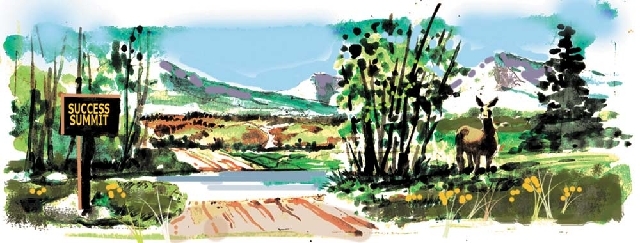Trip of the Week: Enjoy scenic drive on Success Summit Loop near Ely

One of the prettiest side roads in Nevada, the Success Summit Loop near Ely packs a lot of scenery into 38 miles.
The route climbs over a high forested summit after leaving U.S. Highway 93 either north or south of Ely and remains open from snowmelt to snowfall, usually from April through mid-November.
Ely, in White Pine County, is about a half-day’s drive north of Las Vegas. Follow U.S. 93 north from its junction with Interstate 15 near Apex.
From Ely, continue on U.S. 93 about 12 miles toward McGill. The Success Summit Loop begins at a turnoff about five miles north of McGill onto state Route 486. It heads east through a low pass into verdant Duck Creek Valley and then south through ranchlands bordered by the 12,000-foot peaks of the Schell Creek Range. Winter snows supply water to the valley, creating several lively creeks that cut steep canyons into the mountains.
The paved road through Duck Creek Valley accesses unpaved side roads that follow the creeks, popular places for off-highway exploration, fishing, picnicking, camping and hiking. In Humboldt National Forest, there are camping and picnic sites at Bird Creek Recreation Area and Timber Creek Campground.
Family campsites are available on a first-come basis, while group sites require reservations. Trailers or RVs longer than 30 feet are not recommended. Overnight-use fees apply. Both sites have vault toilets. Piped-in water is available at Bird Creek, but water taken from streams for camp use must be boiled or otherwise treated. Bring your own firewood for fire pits and grills or use a propane camp stove.
After about 15 miles, the paved road in Duck Creek Valley gives way to a graded road, which continues for about 16 miles until returning to pavement near the end of the loop back on U.S. 93. The road climbs through pine and fir forests to Success Summit, named for an early mine. Watch for elk and deer keeping an eye on you from the thickets.
Stands of white-trunked aspen turn golden in autumn, making this a worthwhile drive for fall color. In warmer weather, wildflowers riot along the road and in the meadows, particularly the large yellow flowers of the wyethia, better known as mule ears for the shape of their leaves. Several informal campsites have been established by frequent use near the road.
The loop reveals panoramic views of craggy mountains, forested high country and rugged canyons. When the road is dry, it suitable for passenger cars, but higher-clearance vehicles are safer. During snowmelt or after a rain, road surfaces may be slick, particularly on the summit and on the swooping turns descending into the canyon cut by swift-running Steptoe Creek. The route follows the creek down to Cave Lake State Park, where it returns to the pavement. U.S. 93 is about seven miles below Cave Lake, and Ely is eight miles north of the junction.
Open all year, Cave Lake State Park preserves 4,500 acres of woodland, the creek and a 32-acre reservoir. Fees for park entry, camping and boating are charged, discounted $2 for Nevada residents. The lake contains German brown trout, which are native to Steptoe Creek, and stocked rainbow trout.
The park offers summertime picnicking, camping, fishing, boating, swimming, four hiking trails and access to forested roads for off-highway exploration. In winter, Cave Lake freezes enough for ice fishing and ice skating. Enough snow falls most years to attract cross-county skiers, snowshoe trekkers and snowmobilers. One of the park’s two campgrounds stays open all year. A yurt is also available. In January, the park hosts the Fire and Ice Festival, an ice-sculpting competition.
Margo Bartlett Pesek’s Trip of the Week column appears on Sundays.